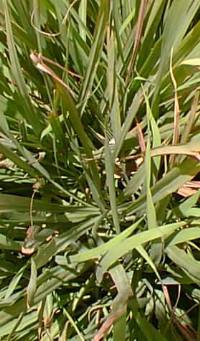USDA: 8-10
Frost Tolerance: Top is tender in Phoenix, but it will grow back from the base in March/April
Sun Exposure: Full sun
Origin: Believed to be native to Burma-China-India area of southern Asia
Growth Habits: Giant grass, most cultivated species grow to 5-7 feet tall (1.5 to 2 m), some much higher.
Watering Needs: Regular to heavy watering
Propagation: Clump division or cuttings (setts) of 2-3 buds
Sugarcane is a tropical grass. Its stalk contains sweet juice from which sugar can be extracted. Most varieties are hybrids of the 4 cultivated species of sugarcane. Saccharum officinarum is the main "ingredient" of the cultivated hybrids. In the USA, it is cultivated for sugar production in Texas (3% of US production), Hawaii(11% of US production), Louisiana(34% of US production), and Florida(52% of US production). It will grow in Phoenix during the warmer time, and will die to the base in winter.
Culture:
Generally, in tropical countries, at least three annual crops can be harvested from a single planting, the original plant cane crop plus two or three additional cuttings, called "ratoon" crops. In Phoenix, the canes are smaller and ripen slower. The percentage of fiber in the pulp is also higher. I have found that 1-year old canes are better when harvested at the end of the summer.
The young stems are covered with small prickles similar to opuntia glochids, and should be handled with gloves, or at least some caution.
Propagation:
It is grown by planting "seed cane," pieces of sugarcane stalk that germinate and produce new sugarcane plants. The cutting needs to be put horizontaly on the ground and buried completely. In Phoenix, plant the cuttings inside in winter, or outside in March-April
Links:
Sugar at LSU
Desert-Tropicals is dedicated to provide gardening advice, gardening ideas, and information about flower of all kind for landscape and collections.We try to check carefully the identification of the plants on the illustrations as well as the other information from the page, but occasionally errors do occur. if you notice anything that needs to be changed please contact us.Thanks.
© 1998-2020 Philippe Faucon, All Rights Reserved.
